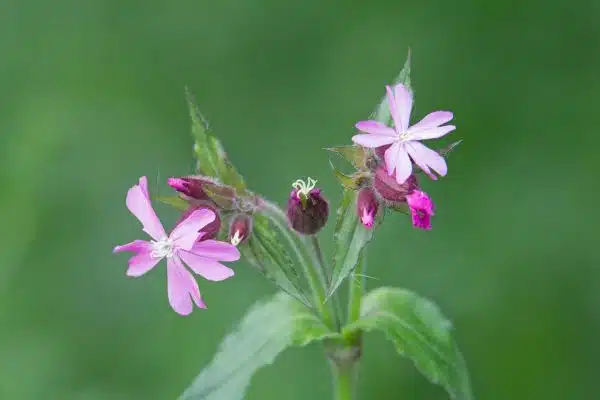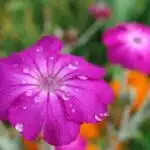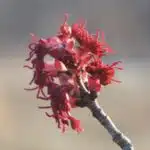Red Campion (Silene dioica) is a popular garden plant that is native to Europe and Asia. It grows well in a variety of settings, including gardens, meadows, and woodlands. Red Campion is known for its attractive pink flowers that bloom all summer long, making it an excellent addition to any garden.
Growing and caring for Red Campion requires some knowledge of the plant’s needs and preferences. This article will provide guidance on how to grow and care for this beautiful plant by discussing the ideal growing conditions, soil requirements, watering techniques, pruning tips, and pest control measures. By following these guidelines, you can enjoy a healthy and vibrant Red Campion that will serve as a stunning centerpiece in your garden or landscape.
Overview Of Red Campion
Red campion, scientifically known as Silene dioica, is a flowering plant native to Europe and Asia. It is a member of the carnation family and is commonly found growing in meadows, woodlands, and along hedgerows. Red campion is an herbaceous perennial that produces showy pink or red flowers from May through July. The plant can grow up to 100 cm tall and has lanceolate leaves with serrated edges.
Red campion has cultural significance in many countries. In England, it is considered a symbol of love and passion due to its vibrant color. It also has a long association with folklore and mythology. For example, according to Irish legend, fairies used red campion to protect themselves from humans by making themselves invisible when they rubbed the plant on their eyes.
In addition to its cultural significance, red campion also has practical uses. Its roots were once used in traditional medicine for their diuretic properties. The leaves and stems have been used to make tea, which was believed to help alleviate respiratory problems such as coughs and colds. Overall, red campion is a beautiful and culturally significant plant with many practical applications.
When it comes to growing red campion, understanding its climate and growing zones is crucial.
Climate And Growing Zones
While red campion is a hardy plant that can tolerate some degree of temperature fluctuations, it’s important to note that the success of your growing efforts will depend on the climate and growing zones in which you live. If you’re living in an area with harsh winters or hot summers, growing red campion may prove to be challenging. However, with the right planting tips and knowledge of climate considerations, you can still enjoy this lovely plant in your garden.
When it comes to planting red campion, timing is key. Ideally, you should sow seeds in late summer or early autumn to allow for sufficient growth before winter sets in. Red campion prefers moist soil that is well-drained and fertile. Before planting, make sure to amend the soil with compost or organic matter to provide adequate nutrients for the plant.
In terms of climate considerations, red campion thrives best in cool temperatures and partial shade. It’s important to keep the soil consistently moist but not soggy as this can lead to root rot. Mulching around the base of the plant can help retain moisture and also deter weed growth. With these planting tips and climate considerations in mind, you’ll be well on your way to successfully growing beautiful red campion in your garden. Next up: choosing the right location for optimal growth.
Choosing The Right Location
Red campion, also known as Silene dioica, is a hardy perennial plant that can thrive in a variety of locations. However, choosing the right location is crucial for its growth and survival. The ideal sunlight requirement for red campion is partial shade to full sun. It prefers at least four hours of direct sunlight but can also tolerate shady areas.
When selecting a location for red campion, soil pH levels should be taken into consideration. Red campion grows best in well-draining soil with a slightly acidic to neutral pH level between 6.0 and 7.5. Soil that is too alkaline or too acidic can affect the growth and health of the plant. It’s important to test the soil before planting and make any necessary adjustments.
To ensure optimal growing conditions for red campion, here are some additional tips:
- Choose an area with good air circulation to prevent diseases.
- Avoid planting in areas prone to flooding or standing water.
- Consider planting red campion near other plants with similar light and water requirements.
- If planting in containers, use a high-quality potting mix specifically formulated for flowering plants.
The next step in successfully growing and caring for red campion is soil preparation and fertilization. Proper preparation of the soil will help provide nutrients needed for growth and increase the chances of successful cultivation.
Soil Preparation And Fertilization
After choosing the right location for your red campion, the next step is to prepare the soil and fertilize it. It is important to understand that healthy soil is essential for the growth and development of any plant. Composting benefits the soil by improving its structure, increasing its water holding capacity, and providing essential nutrients.
Organic fertilizers are an excellent choice for red campion because they are derived from natural sources and release their nutrients slowly over time. They also improve the health of the soil by encouraging beneficial microorganisms to thrive. In contrast, synthetic fertilizers provide a quick burst of nutrients but can damage soil structure and reduce its ability to retain water over time.
When preparing the soil for planting, add compost or organic fertilizer to improve its quality. Spread a layer of compost or organic fertilizer on top of the soil and mix it in with a garden fork or tiller. It’s important not to over-fertilize as this can lead to excessive foliage growth at the expense of flowers.
In summary, preparing your soil with compost or organic fertilizer will provide your red campion with essential nutrients while improving overall soil health. Avoid using synthetic fertilizers which can damage soil structure in the long run. With proper preparation, your red campion will have everything it needs to grow strong and healthy. In our next section, we’ll discuss how to plant red campion for optimal results.
Planting Red Campion
Red campion (Silene dioica) is a herbaceous perennial native to Europe that produces striking pink or red flowers. It can grow up to 60cm tall and prefers well-draining soil with full sun to partial shade exposure. Red campion is commonly planted for its ornamental value, but it also attracts pollinators such as bees and butterflies, making it an excellent companion plant for vegetable gardens.
Planting red campion is relatively easy, and it can be grown from seeds or cuttings. For seeds, sow them in the spring after the last frost in a prepared seedbed or container filled with potting mix. Cover the seeds lightly with soil and keep them moist until they germinate, which usually takes about two weeks. If you prefer cuttings, take them in late spring or early summer when the plant is actively growing. Remove the lower leaves of the cutting and place it in a container filled with potting mix. Keep the soil moist until roots develop, which usually takes about four weeks.
Red campion can also thrive in containers, making it an excellent option for those with limited garden space. Ensure that you use a large enough container that will allow adequate root growth and use potting mix instead of garden soil. Container gardening provides more control over growing conditions such as moisture levels and fertilizer application, making it easier to care for red campion plants.
Now that you have successfully planted your red campion either in your garden bed or container garden, the next step is to ensure that you provide proper watering needs for your plant’s growth and development.
Watering Needs
- The frequency of watering needed for red campion plants is highly dependent on the soil type, weather, and humidity.
- Regularly checking the soil moisture is a good way to determine when the plants need to be watered, as the water requirements may vary from day to day.
- In general, red campion plants need to be watered deeply but infrequently, when the soil is dry to a depth of two to four inches.
- Mulching is recommended for red campion plants, as it helps to retain soil moisture and reduce the need for frequent watering.
Water Frequency
Red campion is a popular flowering plant that requires adequate care to thrive. One of the most important aspects of caring for red campion is watering. When it comes to water frequency, it is crucial to understand the right watering techniques and avoid overwatering.
Watering techniques play a vital role in maintaining optimal soil moisture levels for red campion growth. It is best to water red campion early in the morning or late in the afternoon when the sun is not too intense. This helps prevent evaporation, thus allowing the roots to absorb as much water as possible. Additionally, it is advisable to use a watering can or a hose with a spray nozzle, rather than pouring water directly onto the plants’ leaves.
Overwatering is one of the most common mistakes gardeners make when caring for red campion. Signs of overwatering include yellowing leaves, wilting, root rot, and stunted growth. To avoid these issues, it’s essential to check the moisture level of the soil regularly before watering. Red campion thrives in well-draining soil; hence it’s important not to let excess water accumulate around its roots. By mastering proper watering techniques and avoiding overwatering, you can help your red campion grow into healthy and vibrant plants.
Soil Moisture
Maintaining optimal soil moisture is a crucial aspect of caring for red campion. Watering frequency and drainage solutions have a significant impact on the plant’s growth and overall health. The right watering techniques can help red campion thrive, while overwatering can lead to issues such as root rot, stunted growth, wilting, and yellowing leaves.
To ensure proper soil moisture levels, it’s important to water red campion regularly but not excessively. Overwatering can cause water to accumulate around the roots, leading to poor drainage and root rot. On the other hand, underwatering can cause the plant to wither and die. As such, it’s important to strike a balance between watering frequency and soil moisture levels.
One effective way of maintaining optimal soil moisture is by ensuring proper drainage solutions. Red campion thrives in well-draining soil that allows excess water to flow out easily. If the soil is overly compacted or lacks adequate drainage systems, water may accumulate around the roots leading to root rot or other issues that affect plant growth. Gardeners should be mindful of these factors when planting red campion and take necessary measures such as using well-draining soils or adding organic matter like compost to improve soil structure and drainage capabilities.
Mulching Techniques
Benefits of mulching cannot be overstated in growing red campion. Mulching is important for keeping the soil moist, controlling weed growth, and regulating temperature. The practice also helps to reduce soil erosion by protecting the top layer of soil from wind and water damage.
Different types of mulch are available for use in your garden, but organic mulches are the best option for red campion. Organic mulches come from natural materials such as leaves, straw, bark, and compost. They break down over time to add nutrients back into the soil while suppressing weeds and retaining moisture.
When applying mulch to your garden beds, it is important to apply it evenly around the base of each plant. Avoid covering the stems or leaves with mulch to prevent mold or rot from developing. Mulching once a year in early spring will provide adequate protection for your red campion plants throughout the growing season. With proper mulching techniques, you can enjoy healthy and vibrant red campion plants all season long.
Transition: Now that you understand how beneficial mulching can be for your red campion plants, let’s move on to another crucial aspect of caring for them – pruning and deadheading.
Pruning And Deadheading
Pruning and deadheading are essential techniques to keep your red campion plants healthy and blooming. Pruning involves cutting off any unhealthy, damaged or diseased leaves, stems or branches of the plant. This technique will help redirect the plant’s energy towards healthy growth and prevent it from wasting resources on dying parts.
Deadheading is another crucial technique that involves removing spent flowers from the plant. This process encourages continuous blooming throughout the growing season. Deadheading benefits also include preventing seed formation, which can divert the plant’s energy away from producing more blooms.
To prune your red campion properly, use clean, sharp pruning shears to make a clean cut just above a healthy bud or branch junction. Cut back no more than a third of the plant at any one time to avoid stressing the plant. Deadhead your red campion by pinching or snipping off spent flower heads just below the base of each stem.
In summary, pruning techniques and deadheading benefits are vital for maintaining healthy and blooming red campion plants throughout their growing season. By practicing these simple techniques, you can encourage new growth and extend flowering periods for an eye-catching garden display.
To propagate your red campion plants successfully, there are several methods you can use, including division and seed sowing. These propagation methods require specific care requirements to ensure successful growth and development.
Propagation Methods
- Red campion (Silene dioica) can be propagated by seed sowing, division or cuttings.
- Seed sowing is the most common method of propagating red campion and should be done in the autumn or spring.
- Division is a good method for propagating red campion, as it can be done at any time during the growing season.
- Cuttings are also a reliable method of propagating red campion and should be taken from healthy, undamaged stems.
- All propagation methods of red campion need to be done in well-drained soil and in a location with full sun.
- After propagation, red campion should be watered regularly to ensure the best chance of successful growth.
Seed Sowing
Indoor sowing of red campion seeds can be done in early spring, around March or April. It is important to choose a well-draining soil mix and a container with drainage holes. The seeds should be sown thinly on the surface of the soil and covered lightly with fine soil. Water the container from the bottom and keep it in a bright but cool location until germination occurs.
Outdoor sowing of red campion seeds can be done directly into the garden bed in late spring or early summer, after the last frost date. Choose a location that receives partial shade and has well-draining soil. Prepare the garden bed by removing weeds and loosening the soil to a depth of at least 6 inches. Sow the seeds thinly on the surface of the soil and cover lightly with fine soil. Water regularly until plants are established.
Whether you choose indoor or outdoor sowing, it is important to keep red campion seedlings moist but not waterlogged. Once they have grown their first true leaves, thin them out to at least 6 inches apart if growing outdoors or transplant them into individual pots if growing indoors. Red campion is a hardy plant that can tolerate some neglect, but proper care during propagation will ensure healthy growth for years to come.
Division
Propagation of red campion can be done in various ways, including indoor and outdoor sowing. Division is another method that can be used to propagate this plant. Division involves separating an established clump of plants into smaller sections and replanting them separately. This method can be beneficial because it allows for the creation of new plants without the need for seeds. However, there are also some disadvantages to division.
One of the benefits of dividing red campion is that it can help to rejuvenate older plants. When a plant becomes crowded or overgrown, its growth may become stunted, and it may not produce as many flowers. Dividing the plant will create more space for each section to grow and thrive, resulting in healthier plants with increased flower production. Additionally, division can provide an opportunity to propagate new plants without having to purchase additional seeds or seedlings.
On the other hand, there are some disadvantages to division as a propagation method. One potential downside is that it may cause stress to the parent plant and result in reduced growth or flowering for a period of time after dividing. Additionally, if not done correctly, dividing the plant can damage its roots or stems and potentially harm or kill the plant altogether. It is important to carefully choose when to divide red campion and follow proper techniques to minimize these risks.
Cuttings
Propagation techniques have been an essential aspect of horticulture for centuries. It is the process of creating new plants from existing ones, and it can be done using several methods such as division, sowing seeds, and cuttings. Cuttings are a popular propagation method that involves taking a piece of stem or leaf from a plant and encouraging it to root in soil or water to create a new plant. This technique is particularly useful for plants with woody stems or those that do not produce seeds.
Cuttings can be taken at any time of the year, but it is best to take them during the growing season when the plant is actively producing new growth. To increase their chances of success, gardeners often use rooting hormone on the cuttings before planting them in soil or water. Rooting hormone contains growth hormones that help stimulate root growth in the cutting, increasing its chances of survival.
Overall, cuttings are an efficient way to propagate red campion and other plants without having to buy new seeds or seedlings. However, it requires patience and careful monitoring as not all cuttings will successfully root and grow into mature plants. Nevertheless, with proper techniques and care, gardeners can enjoy creating new plants while expanding their gardens’ biodiversity through this propagation technique.
Common Pests And Diseases
When growing and caring for red campion, it is important to be aware of the common pests and diseases that may affect the plant. One of the most common pests is aphids, which can cause stunted growth and yellowing leaves. These tiny insects feed on the sap of the plant, and can quickly multiply if left untreated.
Preventive measures for aphids include keeping the plant healthy with proper watering and fertilization. In addition, introducing natural predators such as ladybugs or lacewings can help control populations. For an organic solution, a mixture of water and dish soap can be sprayed onto affected areas to suffocate the insects.
Another potential issue for red campion is powdery mildew, a fungal disease that causes a white powdery coating on leaves and stems. This disease thrives in humid conditions and can weaken the plant if left unchecked.
Preventive measures for powdery mildew include avoiding overhead watering and ensuring adequate air circulation around the plant. If detected early, spraying with a solution of baking soda and water or neem oil can combat this disease without harming beneficial insects or pollinators. By taking these preventive measures, gardeners can keep their red campion plants healthy and thriving. The next section will discuss natural pest control measures for those gardeners looking for additional options to protect their plants from pests without using harmful chemicals.
Natural Pest Control Measures
Red campion is a beautiful and hardy plant that requires minimal care. However, pests can be a nuisance, and it is essential to take preventive measures to keep them at bay. One natural way to control pests is through companion planting. This involves planting other plants close to red campion that either repel pests or attract beneficial insects that eat pests. For example, planting garlic and chives around red campion can help repel aphids.
Another natural pest control measure is using homemade remedies. These remedies are made from common household items such as vinegar, baking soda, and soap. For instance, mixing water and vinegar in equal parts and spraying the solution on leaves can deter mites and mealybugs. Similarly, mixing baking soda with water can help prevent fungal diseases.
Incorporating these natural pest control measures not only protects red campion but also promotes biodiversity in the garden by attracting beneficial insects. Whether it’s companion planting or using homemade remedies, these methods are eco-friendly and safe for human consumption. By adopting these practices, we not only serve ourselves but also serve nature.
As horticulturalists, it is our duty to promote safe and sustainable gardening practices. While chemical pest control options are available in the market, they often harm beneficial insects along with pests. Hence adopting natural pest control measures such as companion planting and homemade remedies should be the first line of defense against pests before resorting to chemical options.
Chemical Pest Control Options
To protect your red campion from pests, there are a variety of organic alternatives that you can use instead of chemical pesticides. One option is to attract beneficial insects to your garden, such as ladybugs and lacewings, which feed on harmful pests like aphids and spider mites. You can do this by planting flowers like marigolds and daisies, or by incorporating insectary plants into your garden design.
Another integrated pest management strategy for red campion is companion planting. Some plants can help repel pests or even attract them away from your red campion. For example, planting garlic or chives near your red campion can deter aphids and other insects. On the other hand, planting carrots or radishes nearby can lure pests away from your red campion and towards those plants instead.
When it comes to caring for your red campion, it’s important to monitor for pests regularly so that you can intervene early if necessary. Be sure to check both the leaves and the stems of the plant for signs of infestation. If you do need to resort to using a pesticide, be sure to choose one that is safe for humans and the environment, and always follow the instructions carefully.
Moving onto harvesting and storing red campion…
Harvesting And Storing Red Campion
As the saying goes, “you reap what you sow.” A successful harvest of red campion requires careful planning and attention to detail. When it comes to harvesting, timing is crucial. Red campion should be harvested when the flowers are in full bloom, but before they start to wither.
To store your red campion, there are a few drying techniques that you can use. One method is air-drying. Simply hang your harvested plants upside down in a dry location with good air circulation for several weeks until fully dried. Another option is oven-drying. Lay the flowers out on a baking sheet and place them in an oven set at 100 degrees Celsius for 2-3 hours until fully dry. Once dried, store your red campion in an airtight container away from light and moisture.
Aside from its ornamental value, red campion has culinary uses as well. The flowers can be used fresh or dried as a garnish for salads, desserts or cocktails. They can also be infused into oils or vinegars for added flavor and fragrance.
Moving forward, creative uses for red campion expand beyond just its aesthetic appeal and culinary use.
Creative Uses For Red Campion
Red Campion (Silene dioica) is an attractive species of wildflower that can be used in a variety of creative ways. As a cut flower, it is perfect for bouquets, with its pinkish-red petals and distinctive foliage. For larger floral arrangements, Red Campion can be used in combination with other flowers and foliage to create a striking effect. To ensure healthy growth and blooming of Red Campion, it is important to provide it with direct sunlight and well-drained soil.
Bouquets
Red campion is a beautiful, vibrant flower that can add a pop of color to any bouquet. When incorporating red campion into arrangements, it is important to consider arranging techniques and color combinations. This will ensure that the bouquet not only looks visually appealing but also creates a cohesive and harmonious design.
One of the most important things to consider when arranging red campion is its height. As a taller flower, it works well as a focal point or accent in an arrangement. To create depth and dimension, it can be paired with shorter flowers such as baby’s breath or daisies. Additionally, using contrasting colors like white or yellow can enhance the vibrancy of the red campion.
When choosing color combinations for a red campion bouquet, there are several options to consider. A monochromatic scheme with different shades of pink and red can create a romantic and elegant look. Alternatively, pairing red campion with complementary colors like purple or blue can create a bold and striking design. By experimenting with different color combinations and arranging techniques, you can create unique and beautiful bouquets featuring this stunning flower.
Floral Arrangements
Flower arrangements are an essential aspect of horticulture. They are used to beautify homes, offices, events, and outdoor spaces. Red campion is a stunning flower that can be creatively used in floral arrangements to create beautiful and eye-catching designs. When creating flower arrangements with red campion, it is essential to consider the color combinations and arranging techniques to achieve the desired outcome.
Color combinations play a critical role in determining the overall aesthetic appeal of a floral arrangement. Red campion can be paired with complementary colors like purple or blue to create bold and striking designs. Alternatively, different shades of pink and red can be used to achieve a romantic and elegant look. It is important to experiment with various color combinations when using red campion in floral arrangements to create unique and beautiful bouquets.
Arranging techniques are also crucial when using red campion in floral arrangements. As a taller flower, it works well as a focal point or accent in an arrangement. Pairing it with shorter flowers like baby’s breath or daisies creates depth and dimension in the bouquet. Additionally, incorporating contrasting colors like white or yellow enhances the vibrancy of the red campion. By considering these arranging techniques when creating floral arrangements with red campion, one can achieve visually appealing bouquets that are cohesive and harmonious.
Final Thoughts And Tips For Success
Growing and caring for red campion is relatively easy, as long as you follow some basic guidelines. Remember that this plant prefers a partially shady environment and moist, well-drained soil. It can be propagated by seed or cuttings, but be aware that it has a tendency to self-seed and spread rapidly.
One way to ensure success with red campion is through container gardening. This allows you to control the soil quality and moisture levels, as well as provide adequate drainage. Make sure the container is large enough for the plant’s root system to develop properly. Consider companion planting with other shade-loving plants such as hostas or ferns.
Companion planting can also help deter pests and encourage pollinators in your garden. Red campion attracts butterflies and bees, which are important for pollination of other plants in your garden. Additionally, planting herbs like thyme or chives alongside red campion can help repel harmful insects like aphids or spider mites. With these tips in mind, you can have a successful and vibrant garden full of beautiful red campion blooms.
| Soil Type | pH Level | Sun Exposure |
|---|---|---|
| Moist | 6-7 | Partial Shade |
Table: Guidelines for Growing Red Campion – Ensure the soil is moist and has a pH level between 6-7.
Conclusion
Red campion, also known as Silene dioica, is a beautiful and hardy perennial plant that can add color and texture to any garden or landscape. With proper care and attention, this versatile plant can thrive in a wide range of climates and growing zones.
To successfully grow and care for red campion, it is important to choose the right location with adequate sunlight and well-draining soil. Proper soil preparation and fertilization are also crucial for healthy growth and development.
When planting red campion, it is important to space the plants appropriately and provide regular watering during the growing season. Chemical pest control options may be necessary to protect against common pests such as aphids, but organic methods should be considered first.
Once harvested, red campion can be used in a variety of creative ways including as a decorative accent or in culinary dishes. Overall, this beautiful plant is a wonderful addition to any garden or landscape.
In conclusion, growing and caring for red campion requires patience, attention to detail, and an appreciation for the beauty of nature. Like any living thing, this plant requires proper nourishment and care to flourish. But with dedication and effort, it can provide years of enjoyment and visual appeal. As the famous horticulturalist Luther Burbank once said: “Flowers always make people better, happier, and more helpful; they are sunshine, food, and medicine for the soul.”
Image Credits
- “Red campion (Silene dioica) – Cullompton Leat Fields, Devon – May 2018” by Dis da fi we (featured)





























